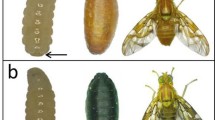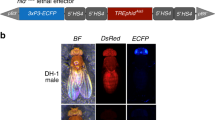Predictions for the use of autosomal translocations for pest control have been made on the assumptions that translocation heterozygotes are semi-sterile and translocation homozygotes are fully fertile and have viabilities which are either equal to or slightly less than that of the wild type. These parameters were assessed in controlled crosses using a translocation in Drosophila and they showed good agreement with expectation. It was expected that in a mixed population of such translocations and wild types, the karyotype at the higher frequency would be favoured by selection. Two cage experiments were initiated with mixed populations of translocation homozygotes and wild types at a frequency of 9:1 in favour of the translocation. Contrary to expectation, the translocation was eliminated from both populations. During this process, there was a reduction in population fertility. Computer studies showed that the results were consistent with a reduction in fitness of the translocation homozygote to about 0.5, i.e. about the same as the semi-sterile heterozygote, so that negative heterosis did not exist and hence frequency dependent selection could not occur.
Similar content being viewed by others
References
Curtis, C. F. (1968). Possible use of translocations to fix desirable genes in insect pest populations. Nature 218: 368–369.
Curtis, C. F. & W. G.Hill (1971). Theoretical studies on the use of translocations for the control of tsetse flies and other disease vectors. Theoret. Pop. Biol. 2: 71–90.
Curtis, C. F. & A. S.Robinson (1971). Computer simulation of the use of double translocations for pest control. Genetics 69: 97–113.
Curtis, C. F., D.Southern, P.Pell & T.Craig-Cameron (1972). Chromosome translocations in Glossina austeni. Genet. Res. 20: 101–113.
Foster, G. G., M. J.Whitten, T.Prout & R.Gill (1972). Chromosome rearrangements for the control of insect pests. Science 176: 875–877.
Frydenberg, O. (1962). Estimation of some genetical and vital statistics parameters of Bennett populations of Drosophila melanogaster. Hereditas 48: 83–104.
LaChance, L. E., J. G.Riemann, & D. E.Hopkins (1964). A reciprocal translocation in Cochliomyia hominivorax. Genetic and cytological evidence for preferential segregation in males. Genetics 49: 959–972.
Laven, H., J.Cousserans, & G.Guille (1972). Eradicating mosquitoes using translocations: a first field experiment. Nature 236: 456–457.
Laven, H., E. Jost, H. Meyer & R. Selinger (1971). Semisterility for insect control. In: Intern. Energy Agency Symposia ‘Sterility principle for insect control or eradication’, Athens. September 1970, pp. 415–424.
McDonald, P. T. & K. S.Rai (1970). Aedes aegypti: Origin of a ‘new” chromosome from a double translocation heterozygote. Science 168: 1229–1230.
McDonald, P. T. & K. S.Rai (1971). Population control potential of heterozygous translocations as determined by computer simulations. Bull. Wld Hlth Org. 44: 829–845.
Muller, H. J. & F.Settles (1927). The non-functioning of genes in spermatozoa. Z. indukt. Abstamm- u. VerérbLehre. 43: 285–301.
Patterson, J. T., W.Stone, P. S.Bedichek & M.Suche (1934). The production of translocations in Drosophila. Am. Nat. 68: 354–364.
Rai, K. S., P. T.McDonald, & Sr., M.Asman (1970). Cytogenetics of two radiation induced, sex-linked translocations in the yellow-fever mosquito, Aedes aegypti. Genetics 66: 635–651.
Robinson, A. S. 1971. A study of chromosome translocations in Drosophila. Thesis. Univ. Bristol.
Robinson, A. S. & C. F.Curtis (1972). Crossing over in a double translocation in Drosophila. Can. J. Genet. Cytol. 14: 129–137.
Serebrovskii, A. S. (1940). On the possibility of a new method for the control of insect pests. Zool. Zh. 19: 618–630. (Russian).
Stevens, W. L. (1946). Accuracy of mutation rates. J. Genet. 43: 301.
VanZon, A. Q. & W. P. J.Overmeer (1972). Induction of chromosome mutations by X-irradiation in the Tetranychus urticae (Tetranychidae) with respect to a possible method of genetic control. Ent. Exp. Appl. 15: 195–202.
Wagoner, D. E., O. A.Johnson & C. A.Nickel (1971). Fertility reduced in a caged native house fly strain by the introduction of strains bearing heterozygous chromosomal translocations. Nature 234: 473–475.
Whitten, J. J. (1970). Genetics of pests in their management. pp. 119–137. In: F. Guthrie & R. L. Rabb (Eds.), Concepts of Pest Management. North Carolina State Univ.
Author information
Authors and Affiliations
Rights and permissions
About this article
Cite this article
Robinson, A.S., Curtis, C.F. Controlled crosses and cage experiments with a translocation in Drosophila . Genetica 44, 591–601 (1973). https://doi.org/10.1007/BF00116813
Received:
Accepted:
Issue Date:
DOI: https://doi.org/10.1007/BF00116813




